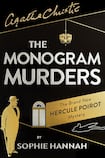
There's no rest for the wicked, they say, but lately it has been those fictional heroes whose job it is to bring the wicked to justice – James Bond, Sherlock Holmes, Philip Marlowe – whose literary rest has been disturbed. The latest fictional detective to be resurrected is Agatha Christie's Hercule Poirot, who featured in more than 30 novels. By some distance the most popular mystery author of all time, Christie's final Poirot novel, Curtain, was published in 1975, although Christie, who died the following year, had written that book some three decades previously.
In Sophie Hannah's The Monogram Murders, set in 1929, we first encounter Poirot, "the retired policeman from the Continent", in "a most enjoyable state of hibernation". When a terrified young woman called Jennie blunders into a London coffee shop and sits at Poirot's table, however, his famous grey cells are energised by her bizarre story. She tells him of her impending murder and asserts that nothing must be done to stop it, as only then will justice be done.
Enter Edward Catchpool of Scotland Yard, a detective who stands in for Poirot's regular sounding-board, Arthur Hastings, to tell the tale of Poirot's investigation. This centres on a triple killing at the Bloxham Hotel, in which two women and a man are discovered identically murdered in three separate rooms, each with a monogrammed cufflink in their mouths. Naturally, the heinous crime is much more complicated than it at first appears, and only Poirot has the required acumen to disentangle the strands. Agatha Christie was justifiably celebrated for her intricate plots, and Sophie Hannah has done full justice to that reputation with a story that baffles to the final page.
Not that everyone is entirely pleased by the bewildering nature of the tale. “Next time you’d like me to grasp something at once,” Catchpool reproves a preening Poirot, “open your mouth and tell me facts. Be straightforward about it. You’ll find it saves a lot of bother.”
Indeed, The Monogram Murders has a double function: the story is told in Agatha Christie's style, but it also partly serves as a critique. While this is a full-blooded Poirot tale, a very English story of murder from the mystery novel's golden age, complete with quaint villages, vicarages, rare poisons, and – a clue! – afternoon tea taken at the wrong time, there are occasions, as above, when Hannah, via Catchpool, gently points to some flaws in Christie's storytelling, particularly when it comes to Poirot's infuriating "method", which often delivered vital clues to the reader about the identity of the murderer very late in the proceedings.
Christie is also criticised for being too mechanical in her plotting, which makes Sophie Hannah an intriguing choice to write a Poirot novel. Hannah's own crime novels are largely concerned with the psychology of criminality, which adds a frisson to Poirot's declaration that "We must think not only of the physical facts but of the psychological". Ultimately, we discover, The Monogram Murders is a novel in which the mechanics of plot, and Poirot's reputation as the canniest of detectives, are harnessed for the purpose of exploring that simplest and strangest of all human emotions, love.
Yet there is much more to The Monogram Murders, as Catchpool the crossword enthusiast discovers to his regret, than the solving of an emotionally charged puzzle. Hannah invests her tale with depth and breadth by investigating the grey areas between sin and crime, as her characters wrestle with Christian morality and the unforeseen consequences of a hypocritical interpretation of the spirit of Christian values.
Further, the core event of the story offers a scenario that might, seen from different angles, be read as murder, execution or assisted suicide. To muddy the waters even more, Poirot asserts the conventional view that “If a crime has been committed, one must ensure that the criminal is dealt with by the law in an appropriate fashion”, only to be confounded at a later point by the declaration: “We were murderers, not according to the law but according to the truth.”
Literary ventriloquism
In a fascinating act of literary ventriloquism from Hannah, the only bum note is struck by the portrayal of Catchpool, who faithfully records Poirot’s every utterance. With his terror of dead bodies, his lack of confidence and his propensity for undermining the investigation, Catchpool may be the most hapless detective ever to grace a mystery novel.
That said, there are occasions when it’s difficult not to be on his side, as when Poirot gathers a host of characters in the hotel dining room for the traditional denouement. “I must say,” Catchpool notes, “I did not and never would understand why he required such a sizeable audience. It was not a theatrical production. When I solved a crime . . . I simply presented my conclusions to my boss and then arrested the miscreant.”
Catchpool makes a valid point, but then Poirot would be nothing without his sense of theatre. He may well be implausible, but his adventures – and The Monogram Murders deserves to take its place among them – are no less enjoyable for all that.
Declan Burke's latest novel is Crime Always Pays (Severn House)










